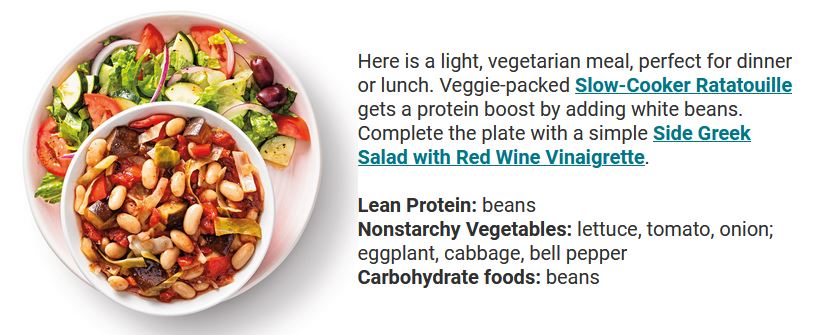For the past year, as the only diabetes nurse educator at a local FQHC clinic, I have had to fine-tune my nutrition coaching skills. We are hoping to hire a dietitian soon, but in the meantime, I am trying to find my nutrition groove as I work with Spanish-speaking clients, kids to elders, and everyone in between.
For many years, I shied away from using the plate method and mostly relied on dietary recalls and figuring out changes needed to improve the health quotient of their current meal plan.
However, as people walk into my clinic room, I am surprised by how many are drawn to the oversized healthy plate place-mats sitting on my display table. They ask, “Can I eat these foods?” This sparks a lively and constructive conversation on new approaches to eating.
Based on this enthusiastic response, after I complete the dietary recall, I jump into our food conversation using the plate method. Whether am I coaching kids to elders on healthy eating, this approach seems to get the best response. If needed, I will dive into more detail around carb serving sizes and matching carbs to insulin.
Using the plate method allows me to keep it person-centered and help them include their favorite foods to maintain the pleasure of eating.
How I use the Plate Method:
This teaching tool is ideal because it has appealing pictures of the different foods that make it easy to provide a quick review of the food groups and their impact on blood sugars and overall health.
In addition, these plates represent a variety of cultures and eating styles, and come in several languages. Here is the one in Spanish I use all the time.

5 Main Pointers
Take a vegetable tour: I start on the left side of this place mat, which has pictures of a variety of healthy high fiber vegetables, which I emphasize are low in calories and packed with nutrients. Then I ask which vegetables are they currently eating and provide encouragement to continue and expand their veggie choices, if possible. “Enjoy an abundance of these super foods, that fill you up, feed your good bacteria, decrease inflammation, help manage blood sugars and support a healthy weight.”
Next stop – CARBS and Beans – There is a lot of misinformation around the carbohydrate group and many people tend to lump them in the “bad food” category. We discuss the carbs they are consuming and discuss some they might be missing out on, like fruits or tortillas, thinking they were off-limits. I encourage 3 servings of fruit daily, (the size of a closed fist) spread throughout the day.
Beans, the magical fruit! I make an intentional effort to sing the praises of beans. They are the inexpensive, fiber-packed nutrition superstars and they are so versatile.
A big focus with carbs is portion sizes. The actual amount of carbs someone is consuming is really easy to underestimate. For this part, I DO pull out my rubber food models, which are as popular as ever.
Canned and Frozen veggies are good for you. Many people may not have access to fresh vegetables or refrigeration. Canned vegetables and soups are often a cheaper, more realistic option. They can choose low sodium if they have hypertension or they can rinse off salty, often less expensive canned vegetables. If they have access to a freezer, frozen veggies offer as many nutrients (and sometimes more) than fresh vegetables, especially if they have been on the shelf for a while.
I encourage starting meals with soups, salads, or water if they are trying to lose weight.
Protein and meats – Our discussion focuses on serving sizes and healthy ways to prepare low fat or skinless meats. If their LDL cholesterol is above target, we will include a discussion on meat alternatives and review cheese consumption.
Sugary Beverages, Sweet Treats, and Snacks – Coffee with a little cream and sugar is fine, but those coffee drinks topped with whip cream can pack lots of carbs and unwanted calories. Replacing sports drinks and sodas with water or unsweetened tea can make a huge difference in glucose levels and body weight.
Mindless muching. I find many people munching on snacks and sweet treats (especially in the evenings) out of boredom or in response to stress. Helping people ask themselves, “Am I really hungry?” before that first bite can make a big difference. Also keeping track of the emotion associated with “mindless snacking” can help people discover other strategies to deal with uncomfortable feelings.
The plate method is simple, engaging of fun. We can customize the plate based on their food favorites and help individuals and families improve their health and feel better!
Resources To Check Out
Get Started on the ADA Diabetes Food Hub – Sign up to save recipes, create a personalized grocery list, and more.
Please visit the ADA’s Diabetes Food Hub recipe page.
They have an abundance of recipes based on budget, preferred foods, time of day, etc… Plus, they also provide the nutrition facts, and it’s FREE!
ADA website: https://www.diabetesfoodhub.org/

Check out Awesome photos and ideas modeling the “Diabetes Plate Method”
USDA Plate Method Website has lots of great info
THE EXCHANGE LIST for Diabetes
Join us for our live streaming of our brand new course
Level 4 | Insulin Calculation Workshop – From Injections to Pumps | 1.5 CEs

Determining basal and bolus rates for multiple daily injections or insulin pumps can seem overwhelming. This 90-minute course provides participants with a step-by-step approach to determine basal rates, bolus ratios and how to problem solve when blood glucose levels aren’t on target. During this 90-minute course, Coach Beverly will provide abundant case studies to give participants hands-on practice and build confidence when calculating insulin doses for a variety of situations.
Objectives:
- Describe using formulas to determine appropriate insulin dosing.
- Discuss strategies to determine and fine-tune basal insulin dose
- Describe how to determine and fine-tune bolus rates including coverage for carbs and hyperglycemia.
- Using a case study approach, utilize calculations to determine the best insulin dosing strategy.
Sign up for Diabetes Blog Bytes – we post one daily Blog Byte from Monday to Friday. And of course, Tuesday is our Question of the Week. It’s Informative and FREE! Sign up below!
[yikes-mailchimp form=”1″]Accreditation: Diabetes Education Services is an approved provider by the California Board of Registered Nursing, Provider 12640, and Commission on Dietetic Registration (CDR), Provider DI002. Since these programs are approved by the CDR it satisfies the CE requirements for the CDCES regardless of your profession.*
The use of DES products does not guarantee the successful passage of the CDCES exam. CBDCE does not endorse any preparatory or review materials for the CDCES exam, except for those published by CBDCE.









